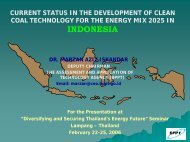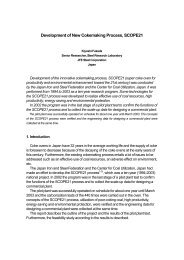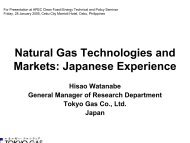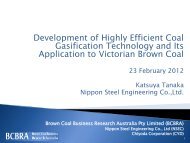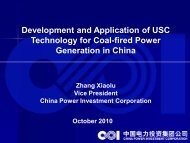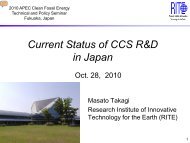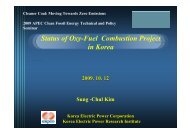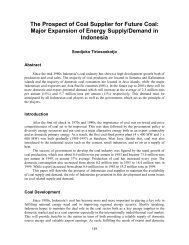Defining CCS Ready: An Approach to An International Definition
Defining CCS Ready: An Approach to An International Definition
Defining CCS Ready: An Approach to An International Definition
- No tags were found...
Create successful ePaper yourself
Turn your PDF publications into a flip-book with our unique Google optimized e-Paper software.
Appendix B: Technology Design Options for a Capture <strong>Ready</strong> Plant• Cheap solvent; and• Low corrosion impact.The main barriers, at present, <strong>to</strong>ward large-scale demonstration of ammonia-based captureare:• Ammonia losses as vapour phase in the discharged flue gases, due <strong>to</strong> its small molecularweight and large vapour pressure—direct discharge in<strong>to</strong> the atmosphere is not allowedin many jurisdictions;• Absorption must be carried out at low temperature <strong>to</strong> minimise ammonia loss (hence,“chilled” ammonia);• High refrigeration load requirements;• Lack of technology maturity and confidence;• Stripper fouling; and• Increased capital costs due <strong>to</strong> the need for several absorber vessels used for minimizingloss of ammonia and maintaining water balance.More broadly, the lack of commercial-scale process experience at this time is limiting thedeployment of this technology. 131Beyond chilled ammonia, there are development efforts on novel solvents for improvedperformance with reduced auxiliary energy consumption, as well as new process designssuch as hybrid membrane-absorbent systems, solid adsorbents, and high temperatureregenerable sorbents. 132 One promising option <strong>to</strong> reduce the efficiency penalty is CaOlooping. 133 In this process, CaO reacts at around 600°C with CO 2 <strong>to</strong> form CaCO 3 . Thiscalcium carbonate can be regenerated at temperatures of around 900°C, and the heatgenerated in the process can be used <strong>to</strong> produce extra power. Weak points are the energypenalty of flue gas reheating and sorbent regeneration and the low stability of the CaOsorbent, leading <strong>to</strong> a large make-up flow of sorbent.While still in the research and development stage, these new technologies may, in thefuture, lead <strong>to</strong> post-combustion capture systems that have lower energy and efficiencypenalties. A big challenge will be proving the reliability at commercial-scale operation. 132B.2 Oxy-fuel Based Capture<strong>An</strong>other promising CO 2 capture approach is <strong>to</strong> use high-purity oxygen for combustion, <strong>to</strong>produce an extremely concentrated stream of CO 2 that is easily compressed and deliveredby pipeline for s<strong>to</strong>rage. The oxy-fuel combustion process, illustrated in Exhibit B-5, beginswith fuel being combusted in pure oxygen and recycled flue gas consisting of water vapour131 Zachary, J.. (2008). CO2 capture and sequestration options - impact on turbomachinery design. Bechtel PowerCorporation.132 Intergovernmental Panel on Climate Change (IPCC). (2005). IPCC Special Report on Carbon Dioxide Capture andS<strong>to</strong>rage. New York, NY: Cambridge University Press.133 Abanades, J.C.. (2002). The maximum capture efficiency of CO2 using a carbonation/calcination cycle of CaO/CaCO3.Chemical Engineering Journal, 90, 303-306. doi:10.1016/S1385-8947(02)00126-2.23 February 2010 82



